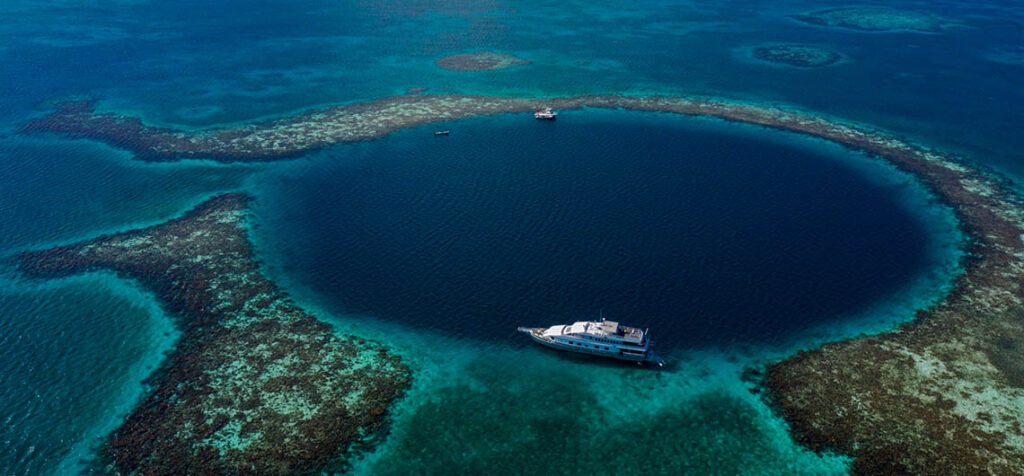Off the coast of Belize, surrounded by the turquoise waters of Lighthouse Reef, lies one of the planet’s most iconic underwater wonders—the Great Blue Hole. From the air, it looks like a perfect circle of midnight blue etched into the sea’s lighter hues, a surreal portal to the deep. But for divers, the real magic begins beneath the surface.
Descending into the Blue Hole is not just a dive—it’s an experience that defies expectation, a journey through geologic time, mystery, and marine life that captures the imagination of all who brave its depths.
What Is the Great Blue Hole?

The Great Blue Hole is a massive marine sinkhole, over 300 meters (984 feet) across and around 125 meters (410 feet) deep. It was formed during past ice ages when sea levels were much lower. Over time, rainwater eroded limestone caves until the roofs collapsed, leaving behind this stunning vertical chasm.
Famed oceanographer Jacques Cousteau brought global attention to the site in 1971, calling it one of the top ten dive sites in the world. Since then, it’s become a bucket-list destination for divers around the globe.
The Descent: What It’s Like to Dive the Blue Hole
Diving in the Great Blue Hole is surreal from the start. As you descend through crystal-clear waters, the reef’s coral gradually gives way to the gaping abyss. The light fades slowly, and a deep cobalt envelops you as you pass the thermocline around 15-20 meters.
At roughly 30 meters (100 feet), massive stalactites begin to appear. These ancient rock formations—some over 10 meters long—are remnants from when the cave was dry land, suspended like underwater chandeliers. It’s an eerie, beautiful sight, like entering a submerged cathedral carved by time itself.
The dive typically bottoms out around 40 meters (130 feet), where narcosis can begin to set in for some. At these depths, marine life is sparse—this isn’t a dive for colorful reef fish, but for the thrill of geological wonder.
While shark sightings are not guaranteed, Caribbean reef sharks and the occasional hammerhead may cruise through the area, adding to the otherworldly feel of the dive.
Who Can Dive the Blue Hole?

The Great Blue Hole is not a beginner-friendly dive. Due to its depth, it is recommended only for experienced, certified divers with Advanced Open Water credentials or equivalent. Dive operators require proof of certification and usually conduct a skills check beforehand.
If you’re not ready to dive, snorkeling the reef edge or flying over the Blue Hole in a small plane are equally unforgettable ways to experience it.
The Journey to Lighthouse Reef
Getting to the Great Blue Hole is part of the adventure. Most dive trips depart from Ambergris Caye, Caye Caulker, or Belize City and involve a 2-3 hour boat ride across open sea to Lighthouse Reef Atoll.
Dive operators typically organize full-day excursions, including two or three dives—one at the Blue Hole and others at nearby sites like Half Moon Caye Wall or Long Caye Aquarium, which are rich in vibrant corals and marine biodiversity.
These additional dives offer a great balance to the dark, cavernous descent of the Blue Hole, showcasing the stunning reef life that makes Belize a world-class dive destination.
Conservation and Exploration

In recent years, the Blue Hole has become a focal point for marine conservation and scientific exploration. In 2018, a team led by Richard Branson and Fabien Cousteau conducted the first-ever 3D mapping of the Blue Hole’s interior using submarines. Their mission revealed unexpected features like hydrogen sulfide layers and deep sinkholes within the sinkhole itself.
The dive also underscored the urgency of protecting this fragile ecosystem. Belize has taken impressive steps, banning offshore oil drilling and expanding marine reserves to protect habitats like the Blue Hole and its surrounding reef systems.
Tips for Diving the Great Blue Hole
- Dive with a reputable operator: Choose companies with strong safety records and environmentally responsible practices.
- Be dive-ready: This is a deep, technical dive. Ensure you’re comfortable with buoyancy control and nitrogen narcosis management.
- Stay hydrated and rested: Long boat rides and early starts mean preparation begins the night before.
- Respect the environment: Touch nothing, take nothing, and leave only bubbles.
Final Reflections
Diving in the Great Blue Hole isn’t about vibrant coral gardens or dense schools of fish—it’s about the sensation of scale, the silence of depth, and the humbling realization that you are visiting a place few humans ever will.
It’s a dive into the Earth’s memory, a vertical journey through layers of history and wonder. For those who make the plunge, it’s not just a dive—it’s a descent into the unknown, and a memory that lingers long after surfacing.
